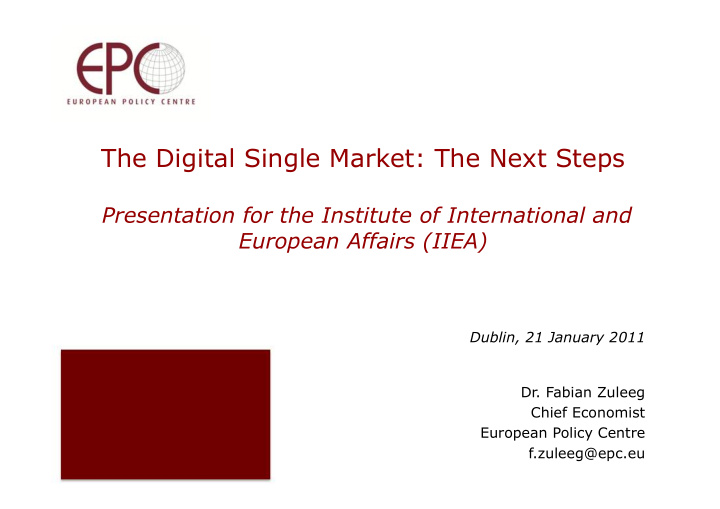



The Digital Single Market: The Next Steps Presentation for the Institute of International and European Affairs (IIEA) Dublin, 21 January 2011 Dr. Fabian Zuleeg Chief Economist European Policy Centre f.zuleeg@epc.eu
Introduction • Dr. Fabian Zuleeg, Chief Economist, responsible for the Political Economy Programme at the European Policy Centre (EPC) • EPC: Brussels-based think-tank: around 400 member organisations (multi- stakeholder membership) • Mission: to make European integration work • Independent, objective and impartial analysis leading to concrete policy recommendations • Digital Single Market project: www.epc.eu/dsm • Contact: F.Zuleeg@epc.eu
Outline • Europe’s growth challenge • The future of the Single Market • The role of the DSM in addressing the growth challenge • What needs to be done to achieve a DSM? • Where are we now?
Europe’s growth challenge • Pre-crisis challenges • Globalisation – global competition (EU from winner to loser?) • Resource competition – increasing resource prices • Climate change – cost of mitigation and adaptation • Demographics – lower growth, lower economic dynamism • Situation aggravated by the crisis • Direct impact of fiscal consolidation on growth (necessary but …) • Structural long term change • Reduced ability of governments to invest into the future • Overall impact: reduced level and potential growth, dangers of divergence • Significant negative impacts of low growth • Labour markets • Sustainability of Europe’s economic and social models (debt) • Europe’s role in the world • Eurozone cohesion
Development of the Single Market Single Market is the key economic integration tool of the EU Potential to boost productivity, growth and employment through gains from increased economic integration The four freedoms: • Strong impetus in 1992 - goods • Difficult process on services - Services Directive in force but limited • Progress on capital but impact of the crisis? • Free movement of people – how to encourage mobility? • Still a need to complete / implement the original four freedoms • Need to deal with conflicts – social Europe • Making SM fit for the future - knowledge economy? • World is changing: need to renew the SM
Europe’s economy is changing • Technology permeating all sectors of society, ubiquitous • New ways of working: working from home, project-based contracts, self- employment, changing boundary between leisure and work • Digital exclusion, language/culture & connectivity • Globalisation: global value chains, increasingly in cyberspace • Knowledge/skills as Europe’s only source of competitive advantage • Outsourcing, including digital outsourcing • Rise of e-commerce • New business models – open innovation, data harvest and sale etc. • ‘Dematerialisation’ – expansion of digital products and services • Knowledge (data, patents etc) as a factor of production (value, availability, access) and key asset, providing returns for individuals and firms
The Single Market must also change • Increasing irrelevance of current Single Market rules • From passively removing barriers to actively building a Single Market – positive measures, harmonisation • Free movement of knowledge – Digital Single Market • Knowledge as an asset (IPR, patents etc.) • Focus on non-material economy (e-banking, e-commerce, e-government etc.) • Human capital crucial: education, mobility/migration, services/people • New/renewed challenges • Consumer protection • Digital crime, identity theft • Data protection • Ability to tax and regulate at national level?
How important is it for the EU? • Increase Europe’s digital sector competitiveness, produce companies of scale • Digital Single Market as a key driver for EU productivity and innovation → adding more than 4% to EU GDP by 2020 • Wider benefits of the DSM: improve labour market efficiency, facilitate more efficient public services and help dealing with the EU’s long term challenges (sustainable development, demographics) • Citizens expect an open, accessible and safe Digital Single Market in Europe – especially the younger generation
EPC recommendations • Key political emphasis on DSM • An online market place consumers can trust • A business environment fit for the knowledge economy • Legal framework for knowledge assets Building foundations and infrastructure •
Progress • High level leadership – Europe 2020 • Broad approach, across policy areas – Monti Report • Different agendas: • Digital Europe • Citizenship Report • Single Market Act • Consultation for SMA • Tackling key issues, including consumer protection, IPR, broadband etc.
Will current proposals deliver? • Political priority – good start but being lost in crisis? • Degree of ambition and overarching vision: fully integrated market? • Risk of fragmentation – sufficient integration across policy areas? • Right policies being debated but lack of details • Do we need more consultation? → Risk of non-delivery is high → Delivery is needed to achieve smart growth → Without decisive action, Europe is facing a lost decade → Without a DSM, SM will lose relevance for future generations
Recommend
More recommend